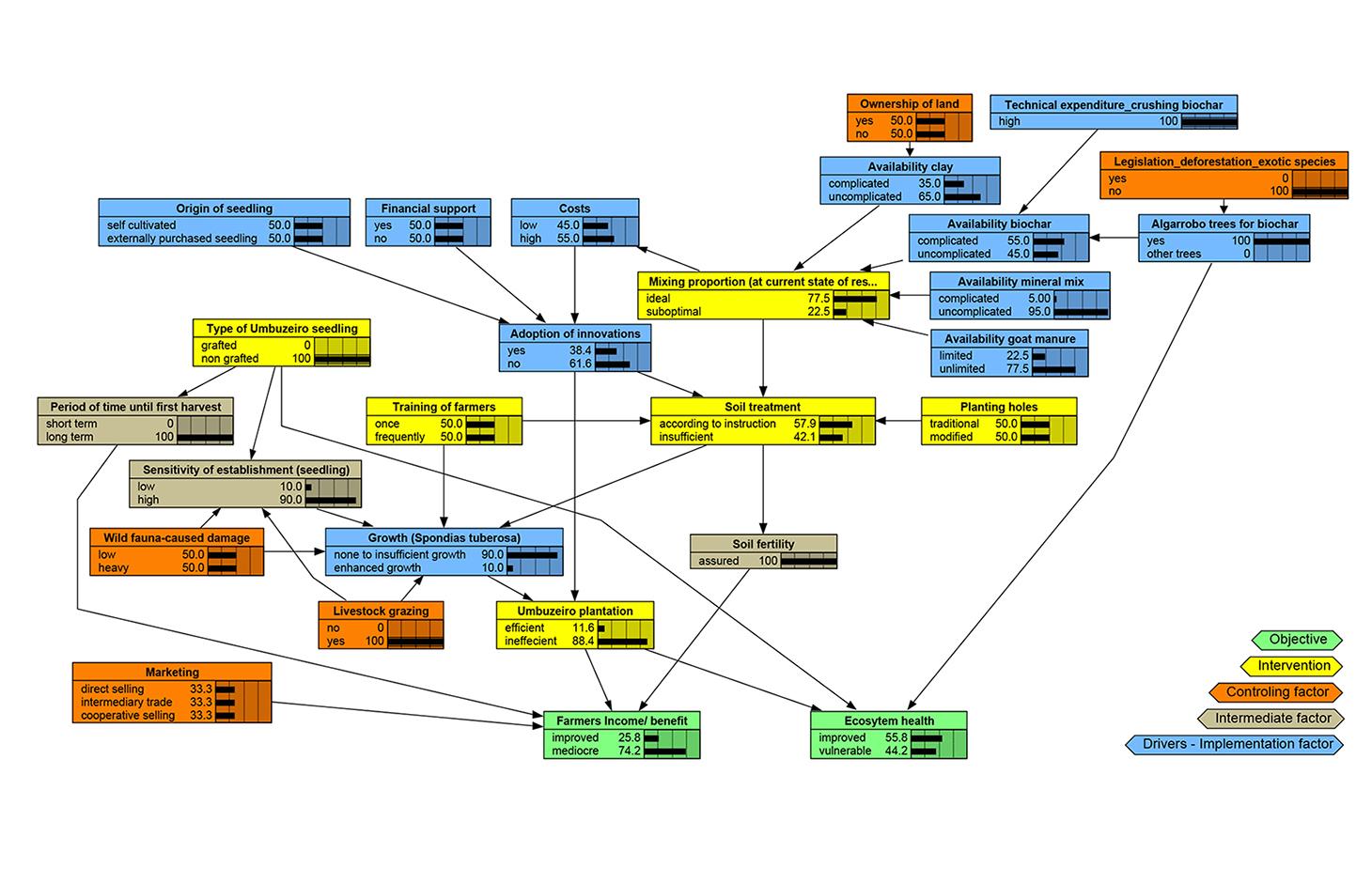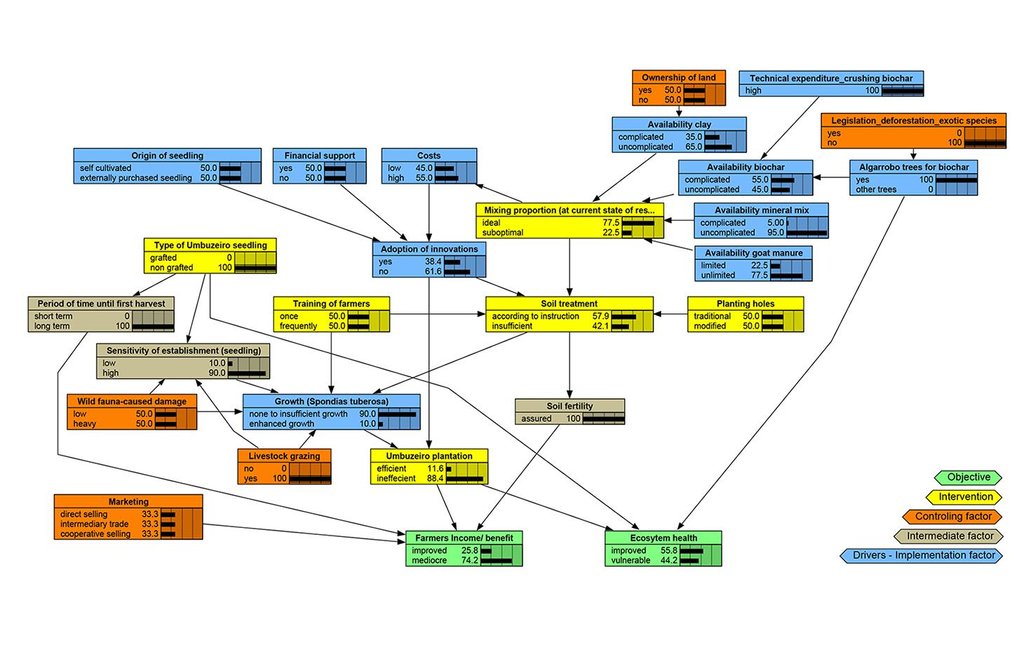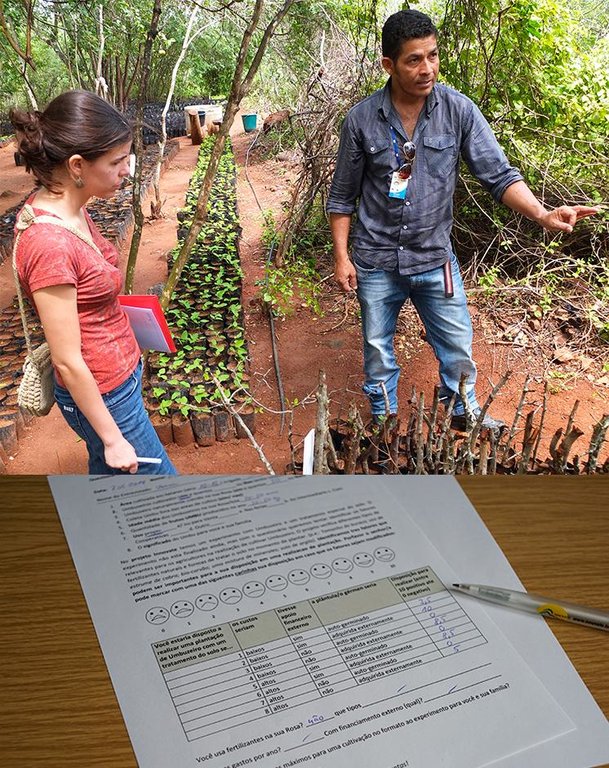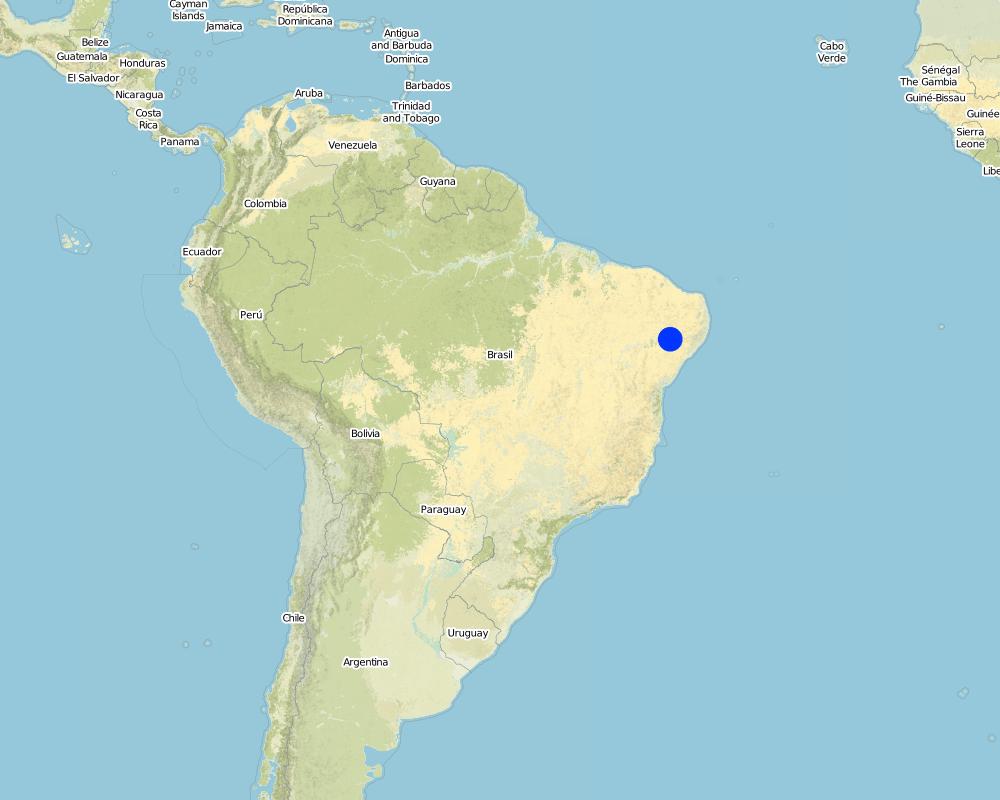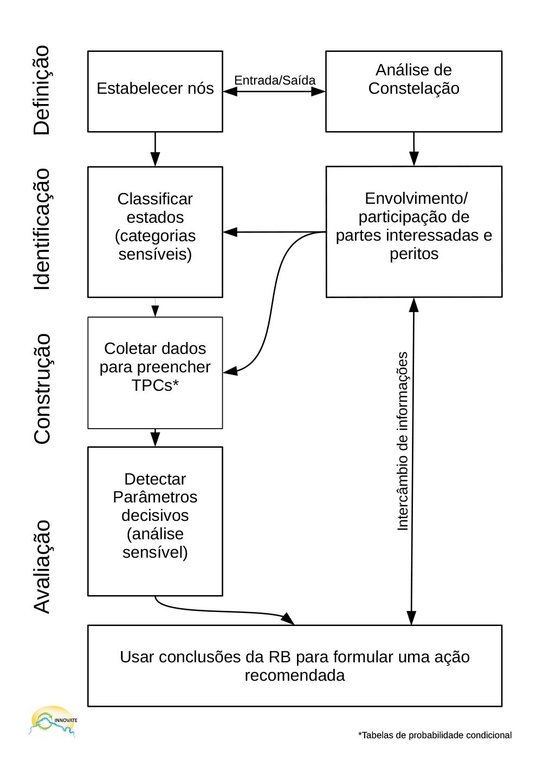Bayesian Network Approach [Бразилия]
- Создание:
- Обновить:
- Составитель: Verena Rodorff
- Редактор: –
- Рецензент: Deborah Niggli
Abordagem com Redes Bayesianas
approaches_1975 - Бразилия
Просмотреть разделы
Развернуть все Свернуть все1. Общая информация
1.2 Контактные данные специалистов и организаций, участвующих в описании и оценке Подхода
Специалист по УЗП:
Специалист по УЗП:
Steinmetz Liron
steinmetz@tu-berlin.de
Berlin Institute of Technology (Technische Universität Berlin), Environmental Assessment and Planning Research Group
Secr. EB 5, Straße des 17. Juni 145, 10623 Berlin, Germany
Название проекта, содействовавшего документированию/оценке Подхода (если применимо)
Book project: Making sense of research for sustainable land management (GLUES)1.3 Условия, регламентирующие использование собранных ВОКАТ данных
Когда были собраны данные (на местах)?
11/12/2015
Составитель и ответственный/-ые специалист(-ы) согласны с условиями, регламентирующими использование собранных ВОКАТ данных:
Да
2. Описание Подхода УЗП
2.1 Краткое описание Подхода
Assessment of the probability and effectiveness of management options or innovations to describe cause-effect-relationships and to make recommendations for action on sustainable land management in the Itaparica region in Northeast Brazil.
2.2 Подробное описание Подхода
Подробное описание Подхода:
The study focus was on the determinants behind the adoption of innovations developed under a scientific project. The specific innovation analysed was intended to benefit both the environment and local smallholder farmers: namely cultivating a multi-purpose, low-growing, to the prevailing harsh semiarid environment well-adapted tree species (Spondias tuberosa L. – so called umbuzeiro). The assessment method was selected as it allows the combination of qualitative and quantitative data, and can be applied even in data-scarce situations. Moreover, it allows downscaling from a broad overview to small-scale management.
Knowledge is collected from different disciplines to support decision-making through the inter- and transdisciplinary approaches of constellation analysis and Bayesian networks. A Bayesian Network (BN) is a probabilistic graphical model that represents a set of variables (elements, nodes) and their conditional dependencies. There are three input components to a Bayesian Network: (a) a set of elements representing factors relevant to a particular environmental system or problem, (b) the links between these elements, and (c) the conditional probability tables (CPTs) behind each node (element) used to calculate the state of the node. Collected data and ratings are arranged in a hierarchical Bayesian Network model in Netica software (Netica 5.12 - freeware up to 15 nodes).
The creation of a Bayesian Network model is as follows: the objectives and necessary interventions for the innovation process aimed at sustainable management are characterized, with scientists arranging a conceptual diagram, including the mapping of elements. States of the nodes are determined through study of the literature and expert consultation (by scientists, stakeholders and experts on related topics). In a final step, a sensitivity analysis is performed on the Bayesian Network to highlight crucial nodes with the highest influence on objectives in order to derive actions to be recommended.
Stakeholder participation is the core process of designing Bayesian Networks. In pre-consultations stakeholders help identifying major influencing factors and relationships. Assessments are compiled in interview sessions enabling the states of the nodes to be quantified later. In this case study, the stakeholders were farmers, farmer-supporting institutions, and expert in soils, vegetation and crops.
2.3 Фотографии, иллюстрирующие Подход
2.5 Страна/ регион/ место, где применялся Подход
Страна:
Бразилия
Административная единица (Район/Область):
Pernambuco, Brazil
Более точная привязка места:
Itaparica Reservoir, Petrolândia
Map
×2.6 Даты начала и окончания реализации Подхода
Год начала реализации:
2014
Год окончания (Если Подход больше не применяется):
2016
2.8 Каковы цели/ задачи Подхода
The principle of Bayesian Network modelling is the integration of multiple issues and system components, where information from different sources can be integrated, while also handling missing data and uncertainty. The outcome may be recommendations that support local management decision-making. As the method is strong in transdisciplinary knowledge integration, it has the potential to become one of the core methods in environmental management.
2.9 Условия содействующие применению Технологии/ Технологий в рамках Подхода или затрудняющие его
Социальные/ культурные/ религиозные нормы и ценности
- содействуют
Наличие/ доступность финансовых ресурсов и услуг
- содействуют
Potential for financial support could be through national small-scale farmer programs; suitable government-sponsored credit programs, public and governmental institutions such as bulk purchasers of agricultural commodities (for instance SEBRAE in Brazil).
Нормативно-правовая база (землевладение, права на земле- и водопользование)
- содействуют
Осведомленность в области УЗП, доступность технической поддержки
- содействуют
Use available free programmes. Use of visual aids such as smileys for evaluation to make questionnaire more comprehensible.
3. Участие и распределение ролей заинтересованных сторон
3.1 Заинтересованные стороны, участвующие в реализации Подхода и их роли
- местные землепользователи/ местные сообщества
Farmers of a resettlement community on dryland; Representatives of the indigenous tribe of Pankararu
- эксперты по УЗП/ сельскому хозяйству
Experts in soil and crop sciences; Expert in vegetation and biodiversity science of the Caatinga
- государственные власти (отвечающие за планирование или принятие решений)
Institute of Agriculture in Pernambuco (IPA); A private company as the hired institution by the National Institute for Colonization and Agrarian Reform - INCRA
- Company of plant breeding, seed science
3.2 Участие местных землепользователей/ местных сообществ на разных стадиях реализации Подхода
| Участие местных землепользователей/ местных сообществ | Перечислите участников и опишите их вовлеченность | |
|---|---|---|
| инициирование/ мотивация | пассивное | Interviews |
| планирование | нет | |
| выполнение | интерактивное | Interviews |
| мониторинг/ оценка | интерактивное | Interviews |
3.3 Схема реализации (если имеется)
Описание:
Simplified work flow of Bayesian Network (BN) showing different steps:
Defining: apply or use already applied constellation analysis (see A_BRA003en) for information and visualization of node setting for the BN model and for stakeholder identification.
Identifying: clarify objectives, implementation factors, interventions, intermediates and controlling factors. Give every node a state, e.g. date, temperature range, amount of precipitation, or a classification: high / low…
Building: Collect data to fill the conditional probability tables (CPTs) behind every node. Prepare questionnaires, ask experts and conduct a literature search. Avoid too much states and no more than four nodes indicating the next node. Finish the model by entering all data in a programme (e.g. Netica).
Evaluating: Compare different scenarios by changing the state of inputs (e.g. from low to high). Show a baseline (without changes), a most improved and least improved scenario to justify recommendations. Finally, hand over recommended actions to stakeholders.
Автор:
Liron Steinmetz, Verona Rodorff
3.4 Принятие решений по выбору Технологии/ Технологий УЗП
Было решение по выбору Технологии (-ий) принято:
- The approach was initiated by scientists.
Поясните:
The approach can be applied to SLM technologies, but also can be employed for other purposes. In our data-scarce case, the method was very helpful as able to deal with different data sources and types.
Поясните на чём было основано принятие решений:
- результаты исследований
4. Техническая поддержка, повышение компетенций и управление знаниями
4.1 Повышение компетенций/ обучение
Проводилось ли обучение землепользователей/ других заинтересованных лиц?
Да
Укажите, кто проходил обучение:
- землепользователи
- местный персонал/консультанты
Тип обучения:
- обмен опытом между фермерами
- опытные участки
Тип обучения:
- workshops
Рассматриваемые темы:
Detecting decisive factors for an ideal scenario of implementation being adopted by land users. For the participants it was interesting to participate in preparing a joint view of their action space - this is generally known in its parts though not with its major interconnections and complexity. Participants especially acknowledged this value added for them.
4.2 Консультационные услуги
Есть ли у землепользователей возможность получать консультации?
Нет
4.3 Институциональная (организационная) поддержка
В ходе реализации Подхода были ли организованы новые институциональные структуры или поддержаны уже существующие?
- да, существенно
Укажите уровень, на котором структуры были укреплены или вновь созданы:
- местные
Опишите организацию, функции и ответственность, членство и т.д.
Decisive factors for the adoption of innovations were identified, including favoring cultivation techniques for Umbuzeiro agriculture (e.g. soil additives).
Укажите тип поддержки:
- повышение компетенций/ обучение
4.4 Мониторинг и оценка
Являются ли мониторинг и оценка частью Подхода?
Да
Если да, будет ли данный документ использоваться для мониторинга и оценки?
Нет
4.5 Научные исследования
Были ли научные исследования частью Подхода?
Да
Укажите темы исследований:
- социология
- экономика / маркетинг
- экология
- технология
Напишите подробнее и назовите тех, кто выполнял исследования:
Research on the situation of local action and governance was a major driver for the workshops. University project members prepared and held the workshops, while also did extended interpretation and integration of results across a number of different workshops.
5. Финансирование и внешняя материальная поддержка
5.1 Годовой бюджет мероприятий по УЗП в рамках Подхода
Если точный годовой бюжет неизвестен, укажите примерный диапазон затрат:
- < 2000
Комментарий (например, основные источники финансирования/ ключевые доноры):
German Federal Ministry of Education and Research (BMBF) 100%
5.2 Финансирование и внешняя материальная поддержка, предоставляемая землепользователям
Предоставлялась ли землепользователям финансовая/ материальная поддержка для применения Технологии /Технологий?
Нет
5.3 Субсидии на отдельные затраты (включая оплату труда)
- нет
Если труд землепользователя был существенным вкладом, укажите, был ли этот вклад:
- добровольный
5.4 Кредитование
Предоставлялись ли в рамках Подхода кредиты на мероприятия УЗП?
Нет
5.5 Другие методы или инструменты стимулирования
Использовались ли другие методы или инструменты стимулирования для продвижения Технологий УЗП?
Нет
6. Анализ влияния и заключительные положения
6.1 Влияние Подхода
Сумел ли Подход помочь землепользователям внедрить и поддерживать технологии УЗП?
- Нет
- Да, немного
- Да, умеренно
- Да, существенно
The different scenarios of the BN tested highlight the good probability of adoption, which then can support sustainable land management.
Сумел ли Подход расширить возможности социально и экономически уязвимых групп?
- Нет
- Да, немного
- Да, умеренно
- Да, существенно
The approach was conducted especially for smallscale farmers without sophisticated irrigation tecniques and as well for the indigenous tribe Pankararu.
Сумел ли Подход разрешить правовые проблемы землевладения/ землепользования, препятствующие использованию технологий УЗП?
- Нет
- Да, немного
- Да, умеренно
- Да, существенно
The BN model offers alternative sources for soil additives in case land use rights are hindering availability.
Сумел ли Подход способствовать улучшению продовольственой безопасности/ качества питания?
- Нет
- Да, немного
- Да, умеренно
- Да, существенно
Not inmediately but a long-term influence is possible.
Did the Approach lead to improved livelihoods / human well-being?
- Нет
- Да, немного
- Да, умеренно
- Да, существенно
The different scenarios of the BN tested highlight the good probability of adoption, which can then benefit the livelihoods of adopters.
6.2 Основные причины, побуждающие землепользователей внедрять УЗП
- рост продуктивности
- рост прибыли (доходности) и рентабельности
- материальное стимулирование/ субсидии
- экологическая сознательность
- well-being and livelihoods improvement
6.3 Долгосрочная устойчивость мероприятий в рамках Подхода
Могут ли землепользователи самостоятельно (без внешней поддержки) продолжать применение того, что было реализовано в рамках Подхода?
- да
Если да, опишите как:
Lessons learnt (especially on most favorable soil additive mixture) improve effectiveness of potential Umbuzeiro cultivation. Stakeholder pool of BN-creation comprises business networking opportunities for land users.
6.4 Сильные стороны/ преимущества Подхода
| Сильные стороны/ преимущества/ возможности по мнению составителя или других ключевых специалистов |
|---|
| The combination of input variables from any given background is possible. |
| Via Bayesian networks changes to the modelled system can be tested prospectively. The space and potential effects of management options can be shown to decision makers. |
| Combining Bayesian networks with Constellation Analysis allows easy determination of major nodes of the model and supports the process of decision-making for sustainable land management activities; methods proved to be very transdisciplinary. |
6.5 Слабые стороны/ недостатки Подхода и пути их преодоления
| Слабые стороны/ недостатки/ риски по мнению составителя или ответственных специалистов | Возможные пути их преодоления/снижения? |
|---|---|
| The statistical component of the Bayesian network approach can be hard to grasp for less educated or near-illiterate stakeholder groups. | Percentages of probability estimations can be translated to a graphical equivalent (e.g. gradual scale of emoticons). |
7. Справочные материалы и ссылки
7.1 Методы сбора/источники информации
- выезды на места, полевые обследования
- опросы землепользователей
7.2 Ссылки на опубликованные материалы
Название, автор, год публикации, ISBN:
Rodorff V., Steinmetz L., Siegmund-Schultze M., Köppel J. (2015) Using Bayesian networks to depict favouring frame conditions for sustainable land management: Umbuzeiro-tree planting by smallholders in Brazil
Где опубликовано? Стоимость?
Session: Methods, tools and impact applications. Tropentag ‘Management of land use systems for enhanced food security - conflicts, controversies and resolutions’, September 16 – 18, 2015, Humboldt-Universität zu Berlin, Berlin, Germany
7.3 Ссылки на материалы, доступные онлайн
Название/ описание:
Innovate project information
Адрес в сети Интернет:
http://www.innovate.tu-berlin.de/v_menue/subprojects/sp7_decision_support_approach_and_project_coordination/sp7_rm1_decision_support_approach/parameter/en/
Ссылки и модули
Развернуть все Свернуть всеСсылки
Нет ссылок
Модули
Нет модулей


